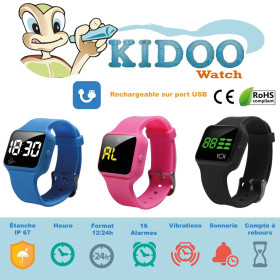Solutions for daytime urinary leaks Voiding Schedule Method If your child has problems with daytime urinary leakage, the first step is to talk to your doctor. Once medical issues are resolved or ruled out, your doctor may recommend a timed voiding program to help your child reduce daytime accidents. This method involves establishing a voiding schedule for your child's toilet visits. Emptying the bladder at regular intervals will reduce the chances of accidental urination. Studies on urinary leakage in children suggest that timed voiding is more effective than medication in treating daytime urinary incontinence. Here are some tips for implementing an effective timed voiding schedule: Start a urination diary to record all accidents during the day and night, then look for relationships between these different accidents. Do they tend to occur at the same times? Are they linked to mealtimes? Can you identify stress triggers? Evaluate how often your child needs to use the toilet and create a schedule accordingly. Discuss this frequency with your doctor and school staff to ensure that the scheduled time will be adhered to when your child is not at home. Use a vibrating watch to help your child remember when it's time to go to the bathroom. There are many different watches available that are specifically designed for timed urination. Look for the style and features that best suit your child. You can ask your child to wear washable absorbent pants such as UnderWunder or Dry & Cool or disposable absorbent pants in case of an accident. If your child's daytime urine leakage problem seems to have stopped after a while, continue using the reminder watch and protective underwear for a few weeks to ensure success and avoid relapses, which are always stressful for the child. Bladder leaks can resurface as a result of new factors in your child's development or may be due to external environmental factors. So keep your child's reminder watch and protective underwear handy in case of a relapse. How does a vibrating watch work? A voiding schedule is a method to force your child to empty their bladder regularly. It's a very effective way to reduce or eliminate daytime urinary leakage problems. You and your doctor can work together to create a schedule that your child can follow each day. To ensure your child stays on schedule, it's recommended to use a vibrating watch that will discreetly alert them when it's time to go. Timed urination watches are programmed to alert the user either at specific times (e.g., 8:30, 11:20, and 4:15) or at predefined intervals (e.g., every three hours) when it's time to go to the bathroom. The number of alarms the user can set varies, so be sure to carefully review all vibrating watch descriptions before purchasing. A vibrating alert lasts between 5 and 20 seconds, depending on the model. Vibrating watch brands like those made by Uriflex and VibraLite look like regular digital watches and come in many different styles and colors. They protect your child's privacy, allowing them to express their personality without being hindered by their bladder weakness issues. Keep in mind that a vibrating watch uses vibrations to alert the user frequently, and therefore requires multiple battery changes over time. Choosing a vibrating watch Very often, all a child needs to prevent urinary leaks is a simple, silent reminder during the day. If your child is at school or daycare when it's time to go, a vibrating watch can help. These timers alert your child when it's time to go to the bathroom. There are many options available - here are some tips to help you choose the right one for your child's needs: Alarm Type: When choosing an alarm, consider what type of alert your child will be most responsive to. Choose from sound, vibration, or a combination of both. Your child may be more comfortable with a vibrating alarm, which is more discreet, while others may prefer to hear the alarm. Audible alarms have the added benefit of alerting teachers and caregivers when it's time for your child to go. In this case, we recommend notifying teachers of this requirement. Alarm Duration: If you're buying a vibrating watch, look at the alarm duration. Most watches offer vibration durations of 5 to 20 seconds. The longer the duration, the less likely your child will miss the alert. Strap: Vibrating watches are available in all sorts of materials and colors, such as Velcro, leather, and polyurethane. The straps can be replaced as needed. The more your child likes the look of the watch, the more you will boost their confidence in this system. Price: Vibrating and sound watches vary depending on their features. Make sure you only buy quality brands, as there are many Chinese copies. To help you decide, you can read customer reviews, compare watches, and contact customer service. Store . For this method to be effective, your child must honor the preset reminders daily, even on weekends. Make sure to set all alarms for convenient times that work during school or childcare activities.













Latest comments